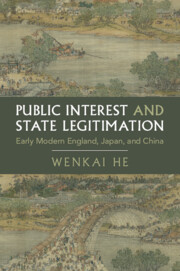Book contents
- Public Interest and State Legitimation
- Cambridge Studies in Historical Sociology
- Public Interest and State Legitimation
- Copyright page
- Dedication
- Contents
- Acknowledgments
- Introduction
- Part I Sources of Early Modern State Resilience
- 1 Legitimacy and Resilience of the Early Modern State
- 2 State–Society Collaboration against Subsistence Crisis
- 3 Financing Public Infrastructure
- 4 The Negotiation of State and Society over Redress of Grievances
- Part II The Emergence of Modern Politics
- Bibliography
- Index
3 - Financing Public Infrastructure
from Part I - Sources of Early Modern State Resilience
Published online by Cambridge University Press: 17 November 2023
- Public Interest and State Legitimation
- Cambridge Studies in Historical Sociology
- Public Interest and State Legitimation
- Copyright page
- Dedication
- Contents
- Acknowledgments
- Introduction
- Part I Sources of Early Modern State Resilience
- 1 Legitimacy and Resilience of the Early Modern State
- 2 State–Society Collaboration against Subsistence Crisis
- 3 Financing Public Infrastructure
- 4 The Negotiation of State and Society over Redress of Grievances
- Part II The Emergence of Modern Politics
- Bibliography
- Index
Summary
Public infrastructural facilities such as dikes, highways, bridges, and seawalls were vital to domestic welfare. Financing their building and maintenance required extensive and sustained state–society collaboration, which was grounded in the shared public interest-based discourse of state legitimation. In fiscally decentralized Tudor and early Stuart England and Tokugawa Japan to 1853, self-governed communities were active in building and managing small- and medium-scale public works. But for large-scale infrastructural facilities, the royal government and shogunate had to become involved through ad hoc financing measures to cover the otherwise insupportable costs. The reverse was true in Qing China prior to 1840. The Qing state could reply upon a centrally managed fiscal system to directly fund the building and maintenance of major public works. For small-scale public works that mainly benefited local residents, it encouraged investment and involvement by local communities and gentry. It also advanced official funds to repair important local water control projects and let the benefited communities return the funds to the state over time without interest.
Keywords
- Type
- Chapter
- Information
- Public Interest and State LegitimationEarly Modern England, Japan, and China, pp. 107 - 144Publisher: Cambridge University PressPrint publication year: 2023

